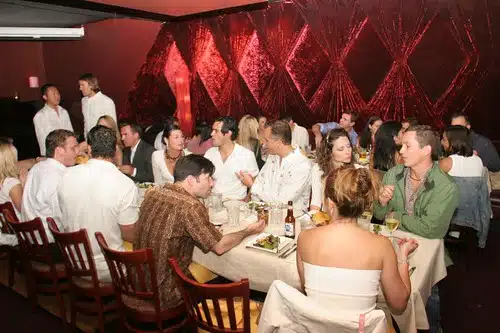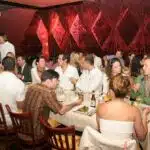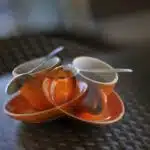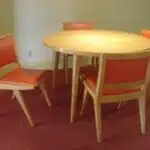Setting a formal table can be a daunting task for many individuals. However, it is an essential skill to have in today’s society where hosting formal events is a common practice. A well-set table enhances the dining experience and adds elegance and sophistication to any occasion. It not only sets the tone for the event but also reflects the host’s attention to detail and hospitality.
As a table setting consultant, I have had the pleasure of helping numerous clients prepare for formal dinners, weddings, and other special occasions. Through my experience, I have come to understand that setting a formal table requires careful planning and attention to detail. In this article, I will provide you with step-by-step instructions on how to set a table for a formal dinner using traditional etiquette guidelines. Whether you are hosting an intimate gathering or a grand affair, this guide will help you create a memorable dining experience for your guests.
Choose The Right Tablecloth
Selecting the right tablecloth is a crucial step in setting the tone for a formal dinner. A well-chosen tablecloth adds elegance to the dining experience and can make a lasting impression on guests. Color coordination is essential when selecting a tablecloth. Consider the color of the room, the dinnerware, and even the food being served. A contrasting tablecloth can create an eye-catching effect, while one that matches the surroundings will provide a more subtle look.
Another important factor to consider when choosing a tablecloth is fabric selection. The material should be appropriate for the occasion, season, and formality of the event. For example, cotton or linen fabrics are ideal for more casual settings, while silk or satin are better suited for formal occasions. Additionally, selecting a high-quality fabric not only enhances the overall aesthetic but also ensures durability and longevity of use.
In summary, selecting the right tablecloth involves careful consideration of color coordination and fabric selection. It’s important to choose a fabric that complements both your dinnerware and surroundings while also taking into account the formality of your event. A well-chosen tablecloth can set just the right tone for your formal dinner and leave an unforgettable impression on your guests as you move onto selecting perfect dinnerware to complete your table setting.
Selecting The Perfect Dinnerware
When it comes to hosting a formal dinner, selecting the perfect dinnerware can set the tone for the entire event. The first step in coordinating your dinnerware is to mix and match different pieces to create a cohesive look. Don’t be afraid to combine different patterns and textures, just ensure that they complement each other.
Another important factor to consider is the color scheme of your dinnerware. A classic white or ivory set is always a safe choice, but adding pops of color can make your table setting more visually interesting. Consider choosing a color that complements the theme of your event or matches any floral arrangements or decor you have chosen.
When selecting your formal dinnerware, keep in mind that this investment will likely last for many years and multiple occasions. Look for durable materials like porcelain or bone china that are dishwasher safe and chip-resistant. By taking the time to carefully choose your dinnerware, you can elevate your table setting and impress your guests with an elegant presentation. In the next section, we will discuss proper placement of the charger plate to complete your formal dining setup.
Proper Placement Of The Charger Plate
When setting a formal dinner table, one important element to consider is the placement of the charger plate. A charger plate, also known as a service plate, is a large decorative plate that serves as a base for other dinnerware. The charger plate is placed at each guest’s seat before any other plates are brought out and is not typically used for serving food.
Decorating charger plates can add an elegant touch to the table setting. Some popular types of charger plates include those made of glass, porcelain, or metal. Glass and porcelain chargers can be decorated with intricate patterns or designs while metal chargers can have a polished or brushed finish. When choosing a charger plate, it’s important to consider the style of the dinnerware and table linens to ensure they complement each other.
Different types of charger plates may be appropriate for different occasions. For example, a simple white porcelain charger may be appropriate for a traditional formal dinner while a brightly colored glass charger could be used for a more modern event. Ultimately, the choice of charger plate will depend on personal preference and the overall theme or style of the event.
As we move onto the next step in setting a formal dinner table, it’s important to keep in mind how the chosen flatware will complement both the charger plate and other elements of the table setting.
Choosing The Appropriate Flatware
Proper flatware selection is crucial when setting a table for a formal dinner. The right flatware can elevate the dining experience, while the wrong choice can detract from it. When choosing flatware, consider whether polished or patterned pieces are more appropriate for the occasion. Polished flatware tends to be more formal, while patterned pieces are better suited for casual settings.
Next, consider whether casual or formal flatware is best for your event. Casual flatware typically has simpler designs with fewer embellishments and is often made of less expensive materials like stainless steel. Formal flatware, on the other hand, often features intricate designs and may be made of precious metals like silver or gold. When deciding between casual and formal flatware, consider the overall tone of your event and choose accordingly.
When selecting individual pieces of flatware, keep in mind that each utensil serves a specific purpose. A complete set should include a dinner fork, salad fork, knife, soup spoon, teaspoon, dessert spoon, and butter knife. Additionally, you may choose to add specialty items such as seafood forks or steak knives depending on your menu. With careful consideration and attention to detail when choosing your flatware pieces, you can create an elegant table setting that will impress your guests.
To further enhance your table setting, consider folding napkins into different shapes. This small touch can add elegance and charm to any occasion.
Folding Napkins Into Different Shapes
Napkin folding is an art that can add a touch of elegance to any formal dinner setting. There are many origami napkin ideas that you can use to create unique and eye-catching designs. From simple folds to intricate designs, there are endless possibilities for creating beautiful napkin arrangements.
If you’re new to napkin folding, don’t worry! There are plenty of online napkin folding tutorials that can help you get started. You’ll find step-by-step instructions for creating a variety of different folds, from basic triangles to more complex shapes like swans and roses. With a little practice, you’ll be able to impress your guests with your newfound skills.
When it comes to choosing the right napkin fold for your table setting, there are a few things to consider. Think about the overall theme or style of your event, as well as the colors and textures of your other table decorations. You may also want to choose a design that complements the shape and size of your dishes and cutlery.
Transition: Now that you’ve learned some creative ways to fold your napkins, let’s move on to another important element of a formal dinner setting: adding elegance with place cards.
Adding Elegance With Place Cards
- Place cards are an important part of setting a formal dinner table and can be used to add a touch of elegance to the dining experience.
- When creating place cards, one should consider the formality of the occasion and the number of guests to ensure that the cards are appropriately sized and labeled.
- Place cards can be decorated to match the theme of the event, such as with a festive ribbon or calligraphy, to give a special touch to the table.
- Other decorative elements, such as name tags, can be used to further personalize the table setting and add a unique flair to the gathering.
Creating Place Cards
One way to add elegance to a formal dinner is by creating place cards. Place cards not only guide guests to their designated seats, but they also serve as a decorative element on the table. Calligraphy options are an excellent way to give place cards an upscale and sophisticated look. The use of different calligraphy styles can create a personalized touch that will make guests feel special.
For those who prefer DIY ideas, there are several options for creating unique and elegant place cards. One idea is to use natural elements such as leaves or flowers and attach them to the card with twine or ribbon. Another option is to use small photo frames or even small easels to display the name of each guest. These creative alternatives will add a personal touch that will make guests feel welcomed and appreciated.
When designing place cards, it is essential to consider the overall theme and color scheme of the event. The font style, paper quality, and size must also be taken into consideration. A skilled table setting consultant will ensure that all these details come together perfectly, resulting in an elegant and cohesive table setting that will leave guests impressed.
Decorating Place Cards
As a table setting consultant, I understand the importance of adding elegance and personalization to formal events. One way to achieve this is by designing place cards that not only guide guests to their designated seats but also serve as decorative elements on the table. DIY place cards are a great option for those who want to add a unique touch to their event. There are several creative ideas that you can use to decorate place cards and make them stand out.
One of my favorite ways to decorate place cards is by using natural elements such as leaves or flowers. You can attach these elements to the card with twine or ribbon, creating a rustic and elegant look. Another option is to use small photo frames or even small easels to display the name of each guest. These creative alternatives will add a personal touch that will make guests feel welcomed and appreciated.
When designing place cards, it is important to consider the overall theme and color scheme of the event. The font style, paper quality, and size must also be taken into consideration. If you’re unsure about how to design your place cards, don’t hesitate to consult with a professional table setting consultant who can help you create an elegant and cohesive table setting that will leave guests impressed. Remember, adding personal touches like DIY place cards is an excellent way to show your guests that you value their presence and want them to feel special throughout the event.
Setting The Water Glass And Wine Glasses
As a table setting consultant, it is essential to create an ambiance that evokes sophistication and elegance. When it comes to glass placement, you must consider the type of dinnerware and the number of courses being served. Ensure that you have enough space on your table to place all glasses without cluttering them. The placement of glasses should be in a straight line or slightly curved inwards towards each other.
Etiquette tips dictate that one should start with the water glass and place it directly above the knife, slightly above the plate’s center. Next, place a white wine glass on its right, followed by a red wine glass next to it. Remember that wine glasses are always placed on the right side of the water glass. It is also crucial to note that champagne flutes are not part of formal dinners but reserved for special occasions such as weddings or anniversaries.
To add an emotional touch to your table setting, incorporate these three items:
- Use crystal stemware – drinking from crystal adds glamour and luxury to any dinner party.
- Vary heights – add dimension to your tablescape by using glasses of different heights.
- Colorful stemware – colored wine glasses can add vibrancy and personality to an otherwise monochromatic table setting.
Now that you know how to set your water glass and wine glasses properly let us move onto adding centerpieces to the table without detracting from your beautiful glassware arrangement.
Adding Centerpieces To The Table
Centerpieces are a crucial element in setting the mood of a formal dinner. They add elegance and sophistication to the table, making it more inviting and visually appealing. Floral arrangements are popular centerpieces that create an exquisite ambiance for any occasion. The choice of flowers should complement the color scheme of the table setting.
When selecting floral arrangements, consider factors such as height, shape, and color. Tall arrangements can obstruct guests’ views or make it difficult for them to converse across the table. Ensure that centerpieces are not too big, so they do not take up too much space on the table. It is essential to choose colors that match or contrast with the table setting’s color scheme to create a cohesive look.
Floral arrangements can be customized according to individual preferences and budget constraints. A simple yet elegant flower arrangement can be created by using one type of flower in varying shades of the same color. Alternatively, a more elaborate centerpiece can be created by combining different types of flowers in complementary hues. The key is to ensure that floral arrangements do not overpower or clash with other elements on the table.
Moving on from floral arrangements, incorporating candles into your formal dinner setting can add warmth and ambiance to the atmosphere.
Incorporating Candles For Ambiance
For a truly elegant and memorable formal dinner, incorporating candles into the table setting is a perfect way to create a warm and inviting ambiance. However, it is important to be mindful of candle placement and the types of candles used in order to ensure safety and effectiveness.
When it comes to candle placement, symmetry is key. Candles should be placed evenly throughout the table, with taller candles in the center and shorter ones on the edges. Additionally, consider using candle holders or candelabras for added height and elegance. It is important to remember that candles should never be placed near flammable materials such as curtains or centerpieces that could catch fire.
As for the types of candles used, there are many options available depending on the desired effect. Tapered candles are classic and add a touch of sophistication, while votive candles offer a more intimate feel. Scented candles can also be used sparingly to add a subtle fragrance to the room. No matter what type of candle is chosen, make sure they are unscented if they will be placed near food so as not to interfere with the flavors.
Moving on from creating an appealing ambiance with candles, table runners and placemats serve as an excellent way to further enhance your table setting design. By adding color or texture through these elements, you can create different moods or complement existing decor themes. Table runners also act as anchors for centerpieces while placemats define each individual’s space at the table. When choosing these items, carefully consider their material – cotton is easy care but linen adds luxury – as well as their colors which should match or compliment napkins and/or chair cushions already in place.
Using Table Runners And Placemats
Table runners and placemats can add an extra layer of elegance to a formal dinner table. When selecting a table runner pattern, it is important to consider the overall color scheme of the table setting. A solid-colored runner can provide a clean and classic look, while a patterned runner can add visual interest and texture.
When choosing placemat materials, there are several options to consider. Fabric placemats can be dressed up with embroidered details or lace edging, while woven placemats made of natural materials like bamboo or rattan can provide a rustic touch. For a more modern look, consider using metallic or acrylic placemats.
Table runners and placemats should complement each other without competing for attention. To achieve this, choose patterns and materials that coordinate with each other and with the rest of the table setting. Remember to keep in mind the formality of the event when making your selections.
Moving on from table runners and placemats, selecting the right tableware for each course is just as important in creating an impressive dining experience. From appetizers to desserts, every dish deserves its own unique presentation. Let’s explore how to properly set the tableware for each course in our next section.
Selecting The Right Tableware For Each Course
When planning a formal dinner, selecting the right tableware for each course is crucial. Not only does it enhance the dining experience, but it also adds to the overall aesthetic of the table setting. When it comes to choosing the perfect tableware, there are a few things to consider.
Firstly, it is important to match the type of plate with the specific dish being served. For example, a salad plate should be smaller in size than an entrée plate and a soup bowl should have a wider rim than a pasta bowl. Secondly, take into account the style and theme of the event when selecting tableware. A classic and elegant dinner may call for fine bone china, while a rustic-themed dinner may require more earthy and natural-looking plates and bowls.
Lastly, pairing wines with each course is an essential aspect of formal dinner menu planning. Different types of wine glasses are designed to enhance specific characteristics of various wines, such as aroma and flavor. It is best to have at least three different types of wine glasses available: one for red wine, one for white wine, and one for champagne or sparkling wine.
In order to create the perfect setting for bread plates, start by placing them on top of your napkin on the left side of your place setting. The bread knife should be placed above or next to them on the left-hand side as well. Remember that all utensils should be placed in order of use from outside inwards towards your plate. This will ensure that guests can navigate their way through each course with ease and elegance.
Creating A Bread Plate Setting
Now that you have selected the right tableware for each course, let us move on to creating a bread plate setting. Bread is a common part of any formal dinner and it is important to know how to properly set and serve it. First, consider the types of bread that will be served. Will it be sliced bread or rolls? This will determine the size and shape of the bread plate.
Bread plate etiquette is also important to keep in mind. The bread plate should be placed above and to the left of the main dinner plate. The butter knife should be placed horizontally across the top of the bread plate with the handle pointing towards the right side of the guest. If rolls are being served, they should be placed in a basket or bowl in the center of the table which can be passed around by guests.
Properly setting a bread plate shows attention to detail and consideration for guests’ needs. Remembering these small details can elevate a formal dinner experience for your guests. In our next section, we will discuss another important aspect of table setting – properly folding tablecloths – which can also make a significant impact on your guests’ dining experience.
Properly Folding Tablecloths
Imagine this scenario: You have just picked out the perfect tablecloth for your formal dinner party, but it looks wrinkled and unkempt when you lay it on the table. As a host, you want everything to look polished and professional, including your tablecloth. This is where proper folding techniques come in.
Tablecloth selection is important, but so is knowing how to fold it properly. Here are four tips for achieving a crisp and clean tablecloth presentation:
- Begin by spreading the tablecloth flat on the surface of the table, making sure to smooth out any wrinkles or creases.
- Next, fold one side of the cloth towards the center of the table, being careful not to create any new wrinkles.
- Repeat this process with the other side of the cloth.
- Finally, fold the ends of the cloth towards each other until they meet in the center.
By following these simple steps, you can ensure that your tablecloth looks neat and tidy for your guests.
As a consultant for setting tables, I cannot stress enough how important it is to pay attention to small details like proper folding techniques for your tablecloths. A well-folded and pressed linen adds sophistication and elegance to any event. Remember that presentation is everything when it comes to hosting a formal dinner party.
Transitioning into adding special touches to your table – once you have mastered proper folding techniques for your tablecloth, you can move on to adding special touches such as decorative napkin folds or embellished place settings. These extra details will elevate your dinner party from ordinary to extraordinary!
Adding Special Touches To The Table
After properly folding the tablecloths, it’s time to add special touches to the table for a formal dinner. Table decorations play a crucial role in setting the tone for the evening. They should be elegant and understated, complementing the overall theme of the event. Candles are a classic choice, providing soft lighting and a warm ambiance. Choose unscented candles so as not to interfere with the delicate flavors of the meal.
Floral arrangements are an excellent addition to any formal dinner table setting. They can be used as centerpieces or placed throughout the space in smaller vases. When choosing flowers, consider their color and size in relation to the rest of the decor. A single type of flower in one color can create a sophisticated look, while mixing different colors and textures can add interest and depth.
To complete the table setting before guests arrive, make sure all elements are properly aligned and spaced out. The centerpiece should not obstruct anyone’s view or impede conversation across the table. Utensils should be set according to traditional etiquette rules, with forks on the left and knives on the right of each plate. And don’t forget about glassware – water glasses should be placed above and to the right of each place setting, while wine glasses go above and slightly to the left of that. With these final touches in place, your formal dinner table will be ready for an unforgettable evening.
As guests begin to arrive, it’s important to shift focus from preparing the physical elements of the table towards hospitality and comfort for your guests. This involves greeting each person warmly at the door upon arrival, offering them drinks or hors d’oeuvres while they wait for everyone else to arrive, and making sure everyone has what they need throughout dinner service. By being attentive and responsive to your guests’ needs throughout their time at your event, you will ensure that they feel appreciated and valued as individuals – ultimately making your formal dinner a success.
Preparing The Table For Guests
Setting the table for a formal dinner is an art that requires attention to detail and careful planning. As a table setting consultant, I recommend starting with choosing appropriate seating arrangements. Seating guests according to their preferences and interests can enhance the dining experience. For instance, it is advisable to seat couples together and avoid placing guests who may not get along next to each other.
Once you have determined seating arrangements, it’s time to set the table. Start by laying out crisp, clean linens that complement your dinnerware. For a formal dinner, use cloth napkins folded into intricate shapes and place them on top of the dinner plate or next to it. Add essential pieces like flatware, glassware, and chargers in their appropriate positions. Make sure the flatware is arranged in order of use from the outside inwards, with dessert utensils placed at the top of the plate.
Dealing with unexpected guests can be challenging but not impossible. Always have extra settings available for unexpected guests or last-minute invites. You can add more chairs around the table or set up a separate table nearby if space permits. Ensure that everyone feels welcome by accommodating their dietary restrictions and preferences whenever possible. Remember that every guest should feel special and appreciated at your formal dinner party.
- Nested bullet point list:
- Tips for choosing appropriate seating:
- Consider personality traits when determining seating arrangements
- Seat guests based on common interests
- Strategies for dealing with unexpected guests:
- Have extra settings available
- Set up a separate table if necessary * Be flexible with seating arrangements to accommodate unexpected guests
Conclusion
When it comes to setting a table for a formal dinner, attention to detail is key. From selecting the right tablecloth to choosing the appropriate flatware, every element plays an important role in creating an elegant dining experience. The placement of each item should be carefully considered to ensure that guests feel comfortable and at ease during their meal.
As a table setting consultant, I understand the importance of creating an atmosphere that is both inviting and sophisticated. With careful attention to detail, it is possible to craft a table setting that will leave a lasting impression on your guests. By following these simple steps, you can create a memorable dining experience that your guests will cherish for years to come.
Remember that each element of the table setting plays a vital role in creating the overall atmosphere. Take time to carefully select each item and consider how it fits into the overall design scheme. From the charger plate to the bread plate setting, every detail should be thoughtfully chosen with your guests’ comfort in mind. By taking care to properly set your table, you can create an ambiance of elegance and sophistication that will make any formal dinner truly unforgettable.
Image Credits
- “Formal Dinner” by Triphoss (featured)





























